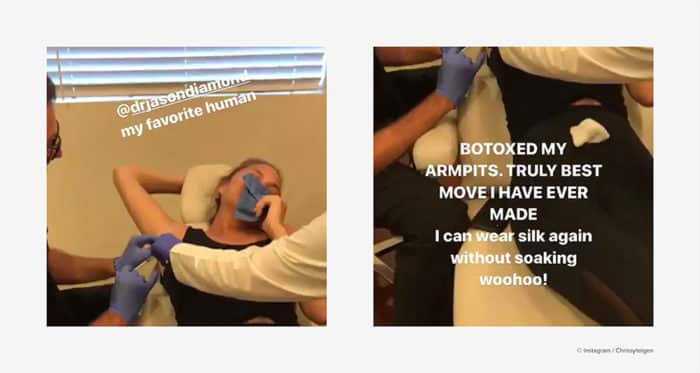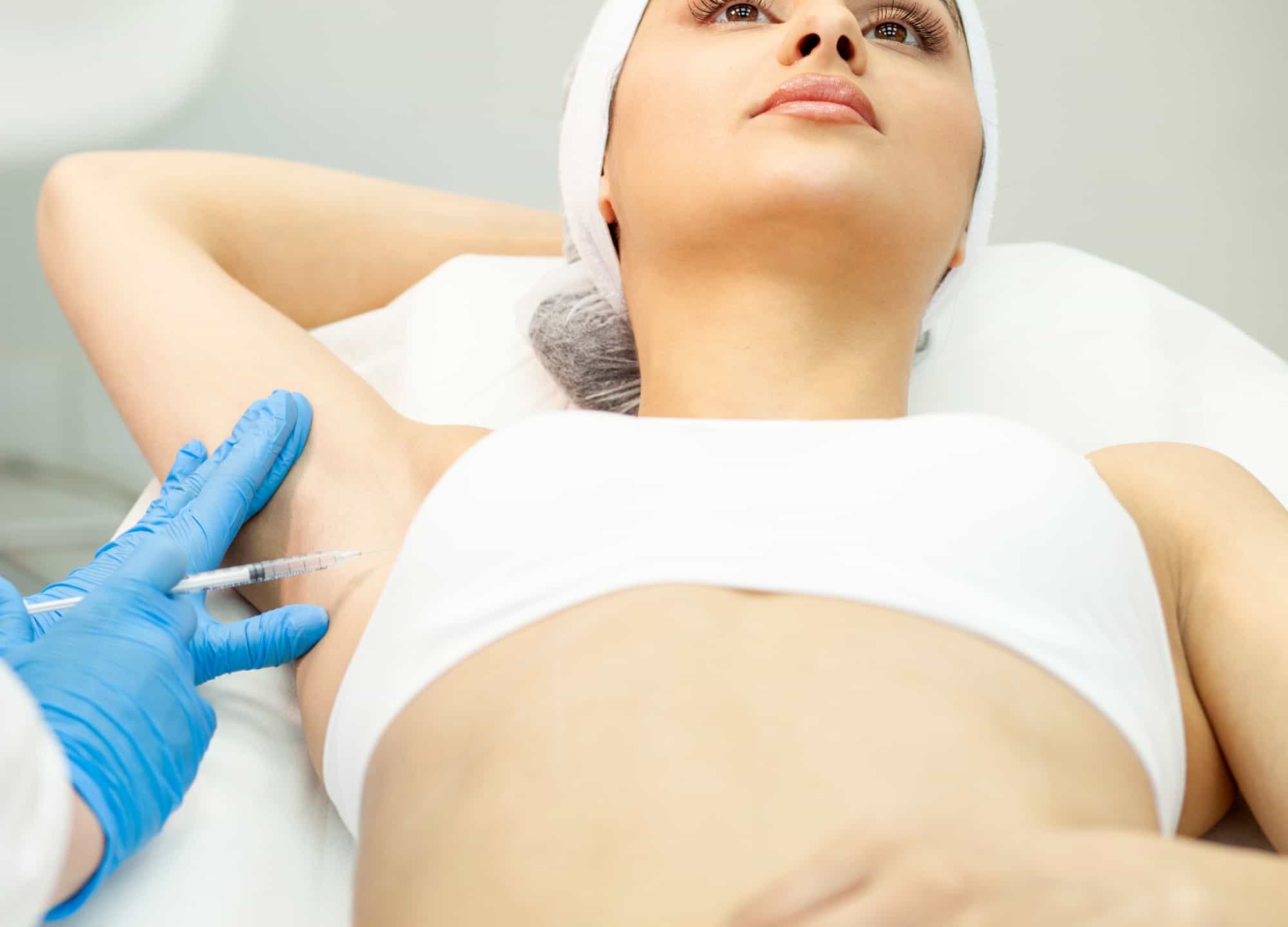Featured Experts
Dr. Janelle Vega, a board-certified dermatologist in Coral Gables, FL.
Dr. Dendy Engelman, a board-certified dermatologist in New York, NY.
Dr. Zain Husain, a board-certified dermatologist in Marlboro Township, NJ.
If you tend to get sweaty enough to ruin makeup and stain clothes, then mothing is more of a relief than the end of summer. Because for some people, sweating isn’t just a minor inconvenience or embarrassment. For those who have hyperhidrosis, or excessive sweating, it’s a catalyst of such intense shame and anxiety that it can cause you to build extra cooling-off time into your schedule or even avoid plans altogether. The good news? There are now a multitude of treatment options available to you.
Your first stop should be your general practitioner for a checkup and bloodwork. This can “rule out any intrinsic systemic causes of sweating, such as hypothyroidism or other hormonal imbalances,” says Coral Gables, Florida, board-certified dermatologist Dr. Janelle Vega. Some medications, like antidepressants, migraine medications and asthma inhalers, can also stimulate excessive sweating, so make sure to tell your doctor everything you’re taking. Finally, figure out your sweat triggers. “I like to determine if the patient has situational sweating, which is caused by emotions or stress, or if it’s random and persistent,” says Dr. Vega.
Once you’ve received a clean bill of health, talk to your general practitioner or dermatologist about some of these effective hyperhidrosis treatment options (ordered from least invasive to most).
Topical treatments
Traditional antiperspirants with aluminum chloride work by physically irritating the sweat glands to shut down perspiration, says Dr. Vega. These are available over the counter—New York City dermatologist Dr. Dendy Engelman notes that Mitchum Advanced Control Antiperspirant and Deodorant contains a very high 20% aluminum chloride—but prescription versions may have an even higher percentage or a more potent version of the ingredient. Try Dr. Sweat or SweatBlock wipes if your area of issue is a part of your body other than your underarms. (However, these aren’t intended for use on the face.)
Additionally, anticholinergics (or nerve blockers), like glycopyrrolate, are standbys for topical use. “These control the neurotransmitters that induce sweating,” says Dr. Vega, and are available by prescription only. Qbrexza is a popular glycopyrrolate wipe widely recommended by doctors.
Brella
Cleared by the FDA in 2023 to treat hyperhidrosis, Brella is an in-office treatment that involves applying a patch for up to three minutes on each underarm. To tackle excessive sweating, it harnesses targeted alkali thermolysis, a reaction in which the sodium in the patch generates heat as soon as it comes into contact with the water in sweat. This thermal energy impairs the sweat glands, temporarily taking them out of commission and reducing sweat production for up to three months. Exactly how long it lasts can be hard to predict, though; in one paper, only half of people still experienced a reduction in sweat after 14 weeks.
Oral anticholinergics
“Anticholinergics, such as glycopyrrolate and oxybutynin, can be taken orally to suppress sweating and are especially helpful for patients suffering from diffuse hyperhidrosis all over the body,” says Marlboro Township, New Jersey, board-certified dermatologist Dr. Zain Husain. Oral medication is also ideal for those with excessive sweating in the facial area, since a topical treatment can be irritating to the delicate skin there.
Pulsed dye lasers
If you struggle with both rosacea and hyperhidrosis, you’ve likely found that the former can exacerbate the latter. And there’s a known connection: a National Rosacea Society study found that when exposed to heat or stress, those with rosacea often produce greater sweating responses than those without the disease. The Cutera Excel V laser targets and shrinks the red, dilated blood vessels in the skin that make you look and feel flushed, and patients have also reported significant decreases in their sweating after treatment.
This makes sense, says Dr. Vega. “Those dilated blood vessels create heat, so your body balances the temperature with perspiration,” she says. “When the rosacea is better controlled, your skin will be less hot—and you’ll sweat less as a result.” This treatment isn’t typically used for hyperhidrosis alone, but if you’re one of the many who battle both rosacea and hyperhidrosis, it may be a win-win for you.
Botox
This neuromodulator isn’t just great for treating the appearance of lines and wrinkles. “Botox works by temporarily weakening the underlying muscle,” says Dr. Engelman. “In addition, this blocks communication between the nerves and the sweat glands, prohibiting the glands from working properly and producing sweat.”
It’s currently approved for sweat reduction, for about six months, in the armpits, on the palms of the hands and on the soles of the feet—but not on the face (though many derms do inject it there off label.) “The doses we use in the approved areas tend to be much higher than we can practically use on the face, since we do not want to cause any facial droops or other complications,” says Dr. Husain.
One such fan of this treatment is Chrissy Teigen, who shared on Instagram that she receives Botox injections in her armpits to help with sweating. Calling it the “best move” she’s ever made, Teigen also reveals that the pain level “really isn’t anything.”

Morpheus8
Morpheus8, a treatment that pairs radiofrequency with microneedles that go deeper than those on comparable devices, is known for its ability to smooth and tighten skin on the face and body. (Just look at the Morpheus8 before-and-after photos for proof.) Research has found RF microneedling to be a good treatment option for hyperhidrosis, since it effectively remodels the tissue around the sweat glands to stymie excessive sweating. Although it has yet to get FDA approval or clearance, the agency is currently running a clinical trial that entails two Morpheus8 treatments, followed by three follow-ups over the course of six months—and plans to have results available (and possible approval) in 2025.
MiraDry
“This noninvasive handheld device delivers controlled electromagnetic energy to the underarm skin, to effectively destroy the sweat glands,” says Dr. Vega. In one to two hourlong sessions, during which the underarms are numbed with local anesthesia, sweat and odor are permanently and dramatically reduced. Plan for several days of discomfort afterward though: underarm swelling, redness and tenderness are common once the anesthesia wears off, and a numb or tingling feeling in the armpits and upper arms can occur for up to five weeks. Serious nerve injury, especially in thinner patients, can also occur.
Nerve ablation surgery
While this surgery, in which a nerve is destroyed or removed, is typically a solution for chronic pain, it’s also a last-case option for hyperhidrosis. “In these extreme cases, patients undergo surgery to cut the main nerve associated with the area of sweating,” says Dr. Vega. Compensatory sweating post-surgery or increased sweating in other areas of the body is likely to occur.











